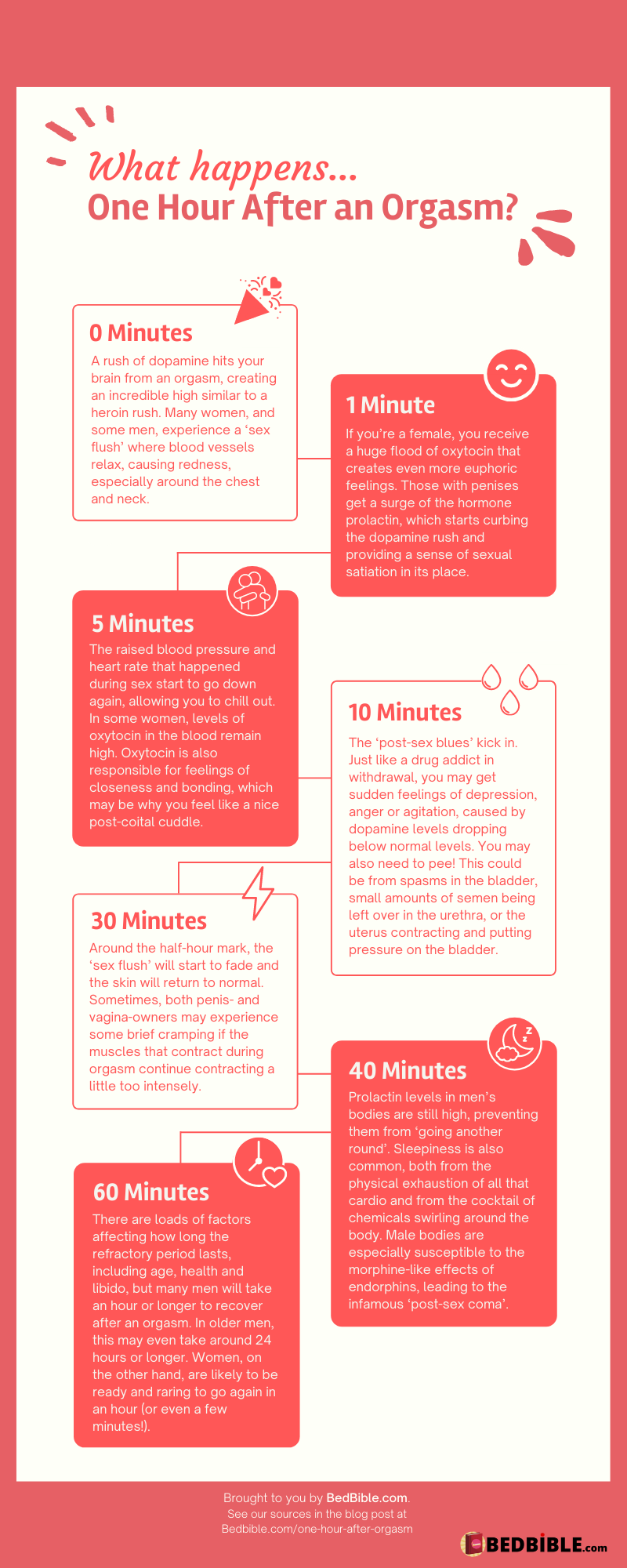
I’ve dug into some scientific research and spoken to medical experts to get to the bottom of exactly what’s happening in your brain and body moment to moment after you climax.
Turns out, there’s a whole load going on behind the scenes. From the precise moment we orgasm, to an hour down the line, your body is put through its paces as all kinds of chemical, physiological, and psychological changes occur.
The story is not the same for everybody, either. Depending on whether you have a vagina or a penis, some pretty different things can be happening under the hood, and we can react in vastly different ways as we recover from our orgasms.
So, without further ado, here’s a snapshot of what happens in one hour after you orgasm…

<p><strong>Please include attribution to bedbible.com with this graphic.</strong><br /><br /><a href='/one-hour-after-orgasm/'><img src='https://wp.bedbible.com/wp-content/uploads/2021/07/One-Hour-After-Orgasm-Infographic.png' alt='What Happens One Hour After Orgasm' width='800px' border='0' /></a></p>0 Minutes After
Directly after an orgasm, a rush of dopamine hits your brain, creating an incredible high similar to the feeling of taking heroin [1]! Many women, and some men, experience a ‘sex flush’ during sex where blood vessels relax and allow more blood to close to the surface of the skin. This causes a red coloration of the skin, especially around the chest and neck [2].
1 Minute After
If you’re a female, you receive a huge flood of oxytocin that creates even more feelings of total euphoria [3]. People with penises, on the other hand, experience a surge of the hormone prolactin, which starts curbing that dopamine rush feeling and providing a sense of sexual satisfaction and satiation in its place [4]. Regardless of gender, the body also starts becoming less responsive to sexual stimulation and wants to avoid any more of it [5]. This is the beginning of the refractory period.
5 Minutes After
The raised blood pressure and heart rate that happened during arousal and sex start to go down again, giving way to a sense of relaxation and gratification [5], so you can chill out and enjoy. In some women, levels of oxytocin in the blood remain high [3]. Oxytocin is also responsible for feelings of closeness and bonding, which may be why you feel like a nice post-coital cuddle [6].
10 Minutes After
In some people, the ‘post-sex blues’ kick in. Just like a drug addict in withdrawal, you may get sudden feelings of depression, anger, or agitation caused by dopamine levels dropping below their usual levels [7][8]. You may also need to pee! This may be due to spasms in the bladder [9], small amounts of semen being left over in the urinary tract and causing a sense of fullness [10], or the uterus contracting and putting pressure on the bladder [9].
30 Minutes After
Around the half-hour mark, the ‘sex flush’ will start to fade and the skin will return to its normal color. Sometimes, both penis- and vagina owners may experience some brief cramping if the muscles that contract during orgasm continue contracting a little too intensely [11].
40 Minutes After
40 minutes after an orgasm, prolactin levels in men’s bodies are still high, hindering feelings of arousal and the ability to ‘go another round’ [4]. Fatigue and sleepiness are also common, both from the physical exhaustion of doing an intense cardio workout and from the cocktail of chemicals swirling around the body. Male bodies are especially susceptible to the morphine-like effects of endorphins, leading to the so-called ‘post-sex coma’, while women can be more susceptible to adrenaline and are more likely to feel alert and energized [12].
60 Minutes After, and Beyond…
There are a lot of factors that affect how long the refractory period will last, including age, health, and libido, but many men will take an hour or longer to recover after an orgasm, feel arousal, and have an erection again. In older men, this may even take around 24 hours or longer [13]. Women, on the other hand, are likely to be ready and raring to go again in an hour (or even a few minutes!).
Hormones Released During Orgasm
The hormones that are released during and after orgasm are a long list of basic chemicals. Both are released in the brain and body.
This table provides an overview of the main chemicals and hormones involved in the sexual response cycle.
Each of these chemicals and hormones plays a unique role in facilitating pleasure, bonding, and other physiological responses during and after orgasm.
| Hormone / Chemical | Time of Release | Released From | What is it, and why is it released? |
|---|---|---|---|
| Oxytocin | During and after orgasm | Hypothalamus (brain) | Often referred to as the “love hormone” or “bonding hormone”, oxytocin is released in response to various types of sensory stimulation, including skin-to-skin contact and nipple stimulation. It plays a crucial role in bonding, social interactions, and maternal behaviors. During sex, its release can intensify orgasms and promote feelings of closeness with one’s partner. |
| Dopamine | During orgasm | Ventral tegmental area (brain) | Dopamine is a neurotransmitter that plays a key role in pleasure and reward. During sex, dopamine levels rise, leading to feelings of pleasure, bliss, and motivation. It’s also responsible for the feelings of euphoria and pleasure during orgasm. |
| Endorphins | During orgasm | Pituitary gland and hypothalamus (brain) | Endorphins are the body’s natural painkillers and mood elevators. They are released during orgasm and help to alleviate pain and induce feelings of pleasure and euphoria. |
| Prolactin | After orgasm | Pituitary gland | Prolactin is a hormone that regulates various functions, including lactation in women. After orgasm, prolactin levels rise, which can lead to feelings of relaxation and satisfaction. It’s also thought to be responsible for the refractory period after orgasm in men. |
| Serotonin | After orgasm | Brain | Serotonin is a neurotransmitter that regulates mood, appetite, and sleep. It’s often called the “feel-good” neurotransmitter. After orgasm, serotonin levels can increase, leading to feelings of relaxation and contentment. |
| Nor-epinephrine | During arousal and orgasm | Adrenal medulla and brain | Norepinephrine is both a hormone and a neurotransmitter. It’s involved in arousal and alertness. During sexual activity, it can increase heart rate and blood pressure, preparing the body for orgasm. |
The difference between male and female orgasms
The human orgasm is a complex physiological and psychological response to sexual stimulation, and both males and females experience it. However, the chemicals and hormones released during orgasm can differ between the sexes.
Female Orgasm
- Oxytocin: Often referred to as the “love hormone” or “bonding hormone,” oxytocin is released in significant amounts during female orgasm. This hormone is associated with social bonding, maternal behaviors, and trust.
- Prolactin: This hormone is released after orgasm and is responsible for feelings of sexual satisfaction. It also plays a role in regulating the menstrual cycle and milk production.
- Endorphins: These are the body’s natural painkillers and are released during orgasm. They can produce feelings of euphoria and pleasure.
- Dopamine: This neurotransmitter is associated with pleasure and reward. Its release during orgasm can lead to feelings of happiness and satisfaction.
Male Orgasm
- Oxytocin: Just like in females, oxytocin is released during male orgasm. It plays a role in sperm transport, prostate function, and bonding.
- Prolactin: In males, prolactin levels spike after orgasm, leading to feelings of sexual satisfaction. It’s also responsible for the refractory period, during which it’s difficult or impossible for a man to have another orgasm.
- Endorphins: These are also released during male orgasm, leading to feelings of pleasure and euphoria.
- Dopamine: Dopamine release is associated with pleasure and reward in males as well.
- Nitric Oxide: This compound plays a role in achieving an erection. It helps relax the muscles in the penis, allowing blood to flow in and cause an erection.
The primary differences
One of the primary differences between male and female orgasms is the presence of ejaculation in males. During male orgasm, semen, which contains sperm, is expelled from the penis.
This process is driven by contractions in the pelvic muscles.
On the other hand, while some women may experience a form of ejaculation (often referred to as “squirting”), it’s not common for all women, and the fluid expelled is not semen.
In summary, while both males and females release similar chemicals during orgasm, such as oxytocin and dopamine, the physiological responses and the roles these chemicals play can vary between the sexes.
Adrenaline during and post orgasms
Adrenaline, also known as epinephrine, is a hormone and neurotransmitter that plays a pivotal role in the body’s “fight or flight” response. It prepares the body to respond to immediate threats by increasing heart rate, redirecting blood flow to essential muscles, and heightening the senses. In the context of orgasms, adrenaline is intricately linked to the arousal phase of the sexual response cycle.
During sexual arousal, both in males and females, there’s an increase in heart rate and blood pressure, partly due to the release of adrenaline. This heightened state of arousal prepares the body for orgasm. In males, adrenaline plays a role in facilitating the process of ejaculation. The rush of adrenaline can intensify the sensations experienced during orgasm, making it more pleasurable.
However, while both males and females experience a surge in adrenaline during sexual activity, the exact effects and levels of this hormone can vary based on individual differences, the type and duration of stimulation, and other physiological factors. It’s also worth noting that excessive adrenaline or prolonged states of arousal without orgasmic release can sometimes lead to feelings of frustration or sexual tension.
In summary, adrenaline is an essential component of the sexual response cycle, contributing to the heightened sensations and physiological changes that occur during sexual arousal and orgasm in both males and females.
Sources
[2] Bustle – Things that can happen to your body after sex
[5] Healthline – Everything you need to know about the refractory period
[6] ScienceAlert – Here’s what happens to your body and brain when you orgasm
[7] HelloGiggles – 11 weird things that can happen to your body after sex (that are no big deal)
[9] Bustle – Why do you feel like you have to pee after sex?
[10] Netdoctor – Why do I feel the urge to urinate after sex?
[11] Medical News Today – What causes cramps after sex?
[12] Insider – Here’s why you feel so tired after having sex
[13] Men’s Health – How soon after an orgasm can you start again?
